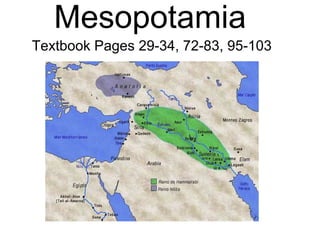
Mesopotamia Chart
- 1. Mesopotamia Textbook Pages 29-34, 72-83, 95-103
- 2. Sumerians Sumer, Kish, Eridu, Uruk, Ur (Near the Persian Gulf) 3000BC Pictographs Cuneiform, stylus Arches (keystone), ziggurats temples baked brick in layers Invented plow, sailboat, circle in 360 degrees, wheel Used levees and canals City-State each had god(s) Monarch king, high priests, nobles, merchants, scholars, peasants, farmers, slaves Upper-class boys attended school Polytheism – gods – forces of nature no reward or punishment after death Gods: An – god of heaven Enlil – god of air + storm Enki – god of water and wisdom Flood Story – gods are unhappy with human life, send a flood
- 3. Babylonians Akkad, Babylon 1792 BCE Active Traders, Rights for Women Adopted culture of Sumerians when they conquered them Astronomy/Astrology Horoscope Hammurabi Law Code “eye for an eye” Hammurabi – efficient leader, cared about people, wanted Justice Polytheistic had Sumerian gods would sacrifice to gods for favors Shadowy afterlife like Sumerians Priests could tell future wealthy
- 4. Hittites Asia Minor, IndoEuropean Language 1600BCE-1200BCE Warlike people invade from Asia Minor Looted city of Babylon Retreat to West Fertile Crescent 1st to smelt iron Only major crimes received death penalty You could pay fines for penalties Had significant religious freedom
- 5. Assyrians Ashur, Upper Tigris River, Ninevah 2000BCE, 900-650BCE, 700BCE Loot/destroy Babylon, 635BCE Civil War Semetic Speaking from North Mesopotamia Adopt Sumerian culture Fierce effective warriors, 1st to use cavalry, had a standing army Expand power into Egypt/Fertile Crescent height of power Meso, Syria, Palestine, Nile Valley Latitude//Longitude, Used circle, Medical Science, Mail service Used terror to control enemies, enslaved people they conquered, killed enemy soldiers, deport populations cultural diffusion Governed large Empire Respect/feared other people’s gods Gods controlled everything King of Assyria responsible only to God Ashur Nineveh is Capital – double walled for protection Ashurbanipal’s Library at Nineveh Epic of Gilgamesh
- 6. Chaldeans Nineveh, Babylon 612BCE capture Nineveh Conquer most of Fertile Crescent Trade, canals, buildings Hanging Gardens of Babylon Skilled astronomers predict solar/lunar eclipse Calculate length of the year Gate of Ishtar - Goddess Nebuchadnezzar – Great Leader, builds Hanging Gardens of Babylon for his homesick wife
- 7. Persians Indo-European language, Empire Indus R. to Europe 539-331BCE Finally defeated by Greeks and Alexander the Great Empire stretched from Indus River to Europe Road System was used to connect Empire together Imperial Bureaucracy- gov’t organized into different levels and tasks with a king at the top. Cyrus, Darius, Xerxes expanded Empire Collected taxes laws fairly executed Conquered people let them keep their religion and laws Secret Agents Keep king informed, governors and military leaders were kept in check Zoroastrianism good vs. evil, either rewarded or punished in the afterlife. Had influence of Judaism and Christianity
- 8. Phoenicians West Fertile Crescent, “Phoenicia”, Tyre and Sidon = Seaports, Carthage in Africa - Traders 1000BC Ships highly skilled sailors, greatest traders Lumber, skilled metal workers, invented glass blowing and purple dye Phoenician Alphabet spread throughout Mediterranean. Model for later Western alphabets City-Stateeach with a different King Copied culture and government of others (Egyptian and Babylonians) Afterlife sacrifice to please the gods, even children (extreme cases)
- 9. Lydians Asia Minor, West Asian Minor = Lydia 600BC no empire 1st to use coined money created a money economy Barter = trading goods or services for other commodities
- 10. Hebrews/Jews Canaan, Enslaved in Egypt After 100BCE Hyksos kicked out Jews and are made slaves in Egypt for 400 yrs. Founder Abraham Moses Leads Exodus from Egypt, 10 Commandments Yahweh (God) monotheistic Torah (1st 5 books of Old Testament) Law Code Diaspora the spreading out (forced or voluntary migration) of Jews from their homeland.